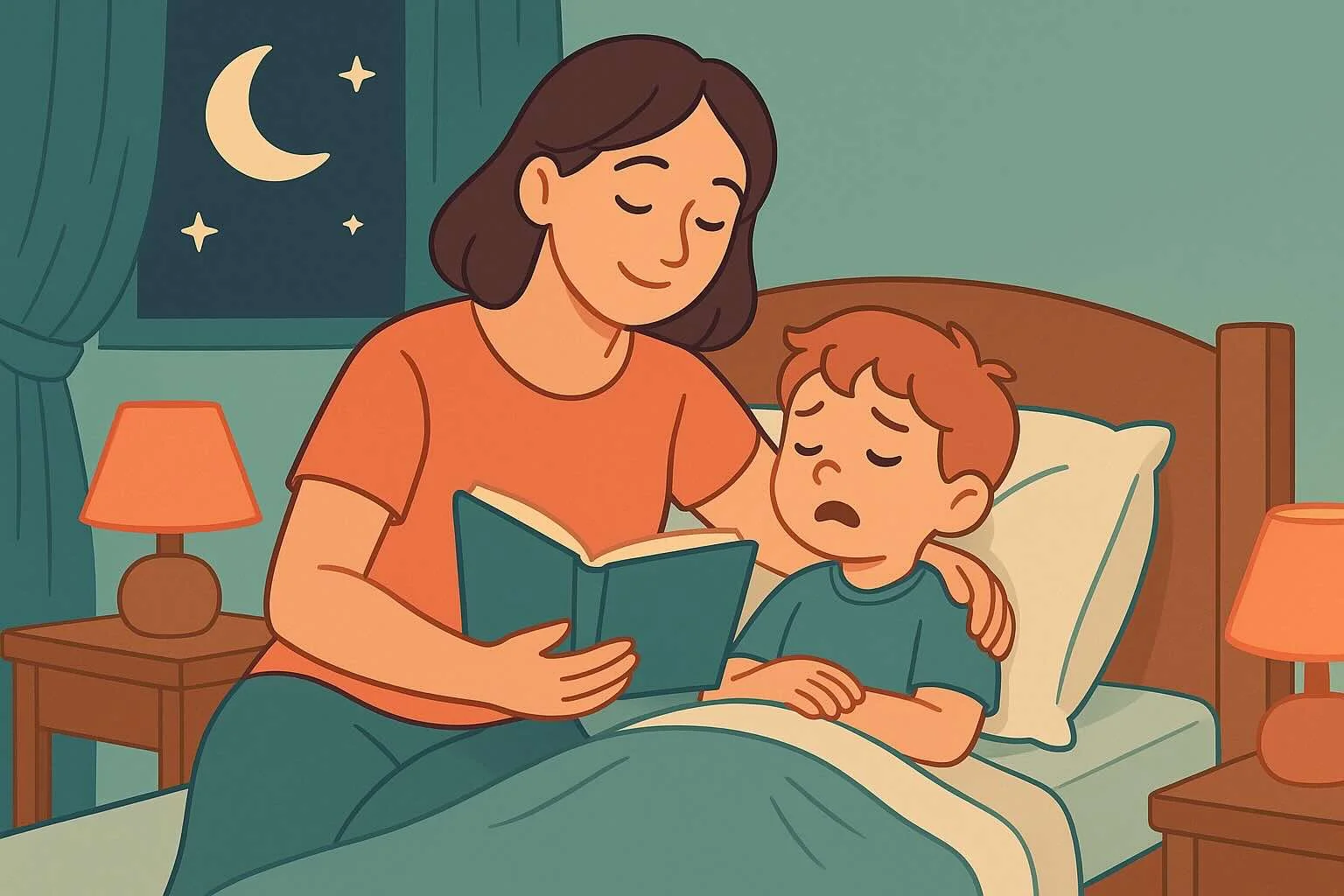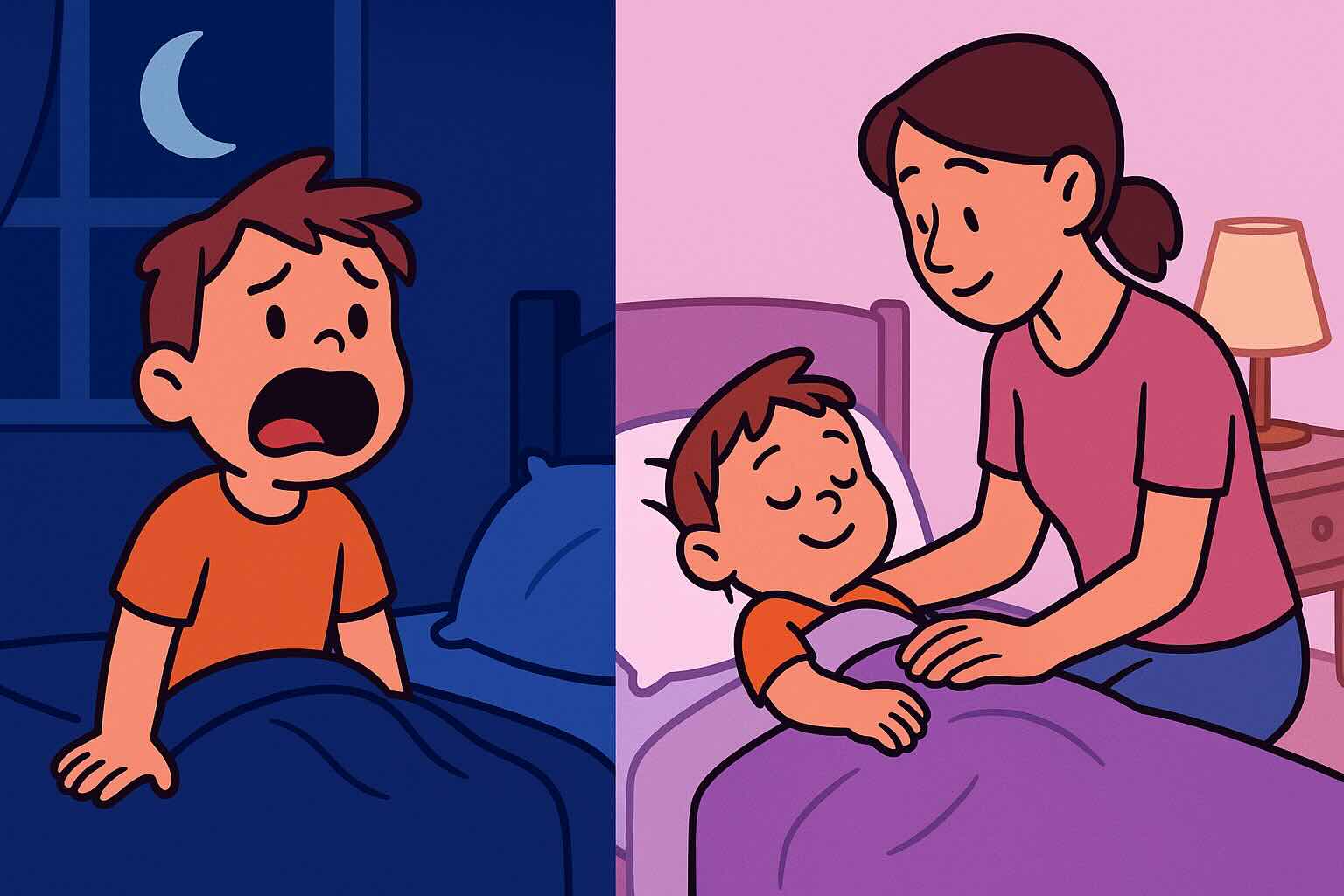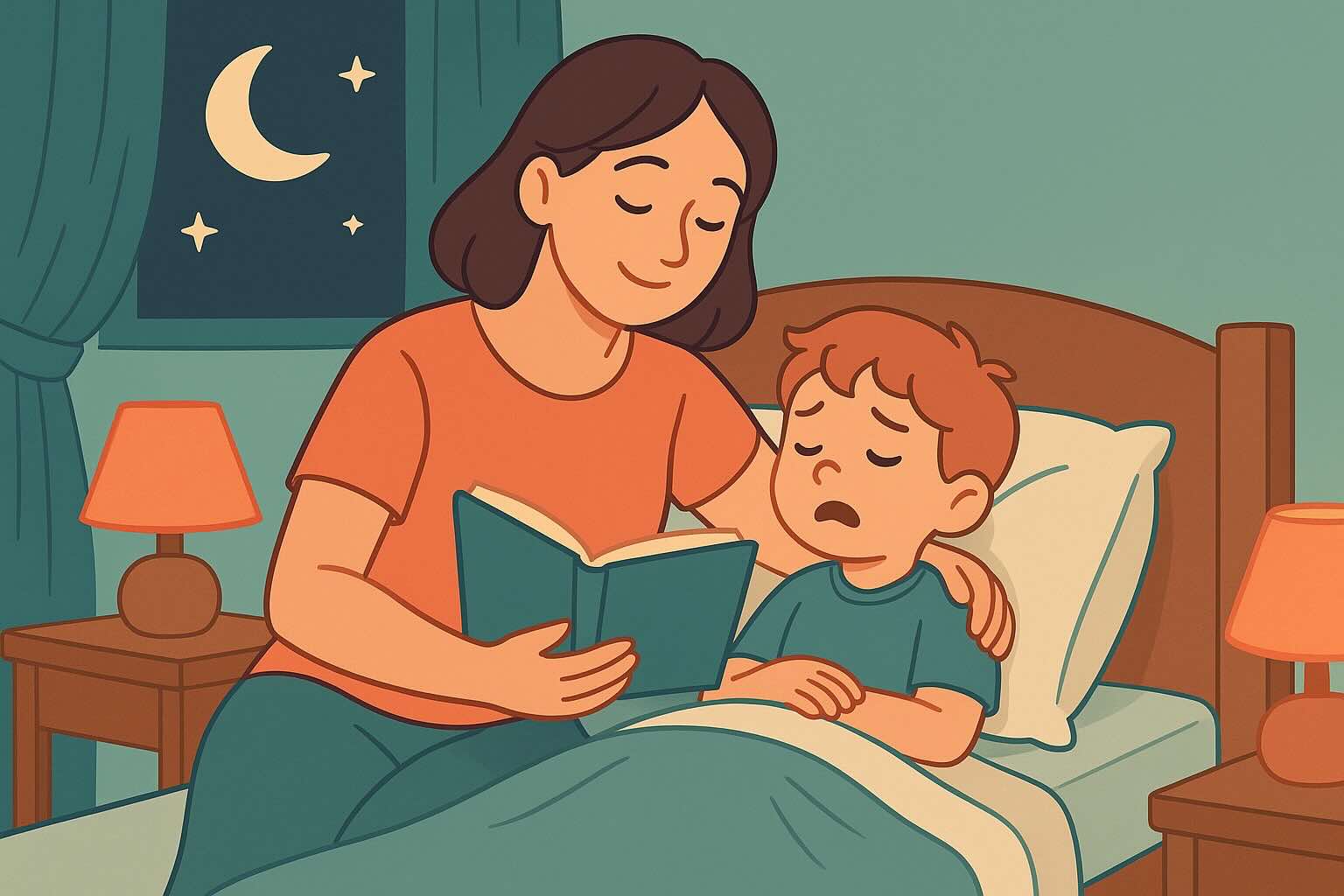How to Stop Bedtime Battles: Complete Guide for Ages 3-7

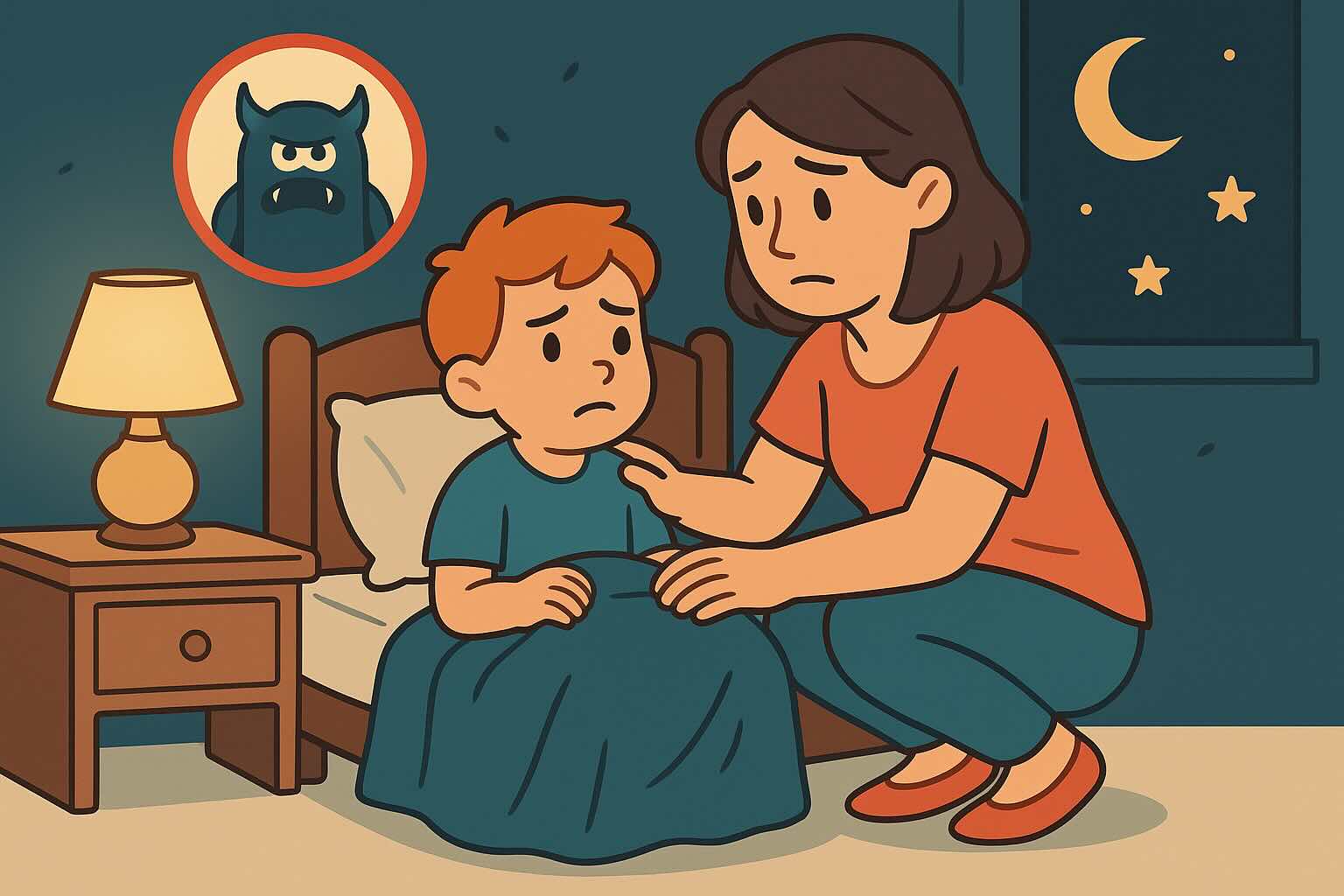
If you're dreading bedtime every single night, watching the clock with mounting anxiety as 7 PM approaches, you're not alone. Research shows that 75% of parents of preschool and school-age children report bedtime battles, but here's the encouraging news: most families see dramatic improvement within 2-3 weeks using the right approach.
Bedtime challenges often intersect with daytime behavior issues, so if your child is also experiencing frequent tantrums during the day, you might find our complete guide to handling toddler tantrums helpful for understanding the broader emotional regulation patterns.
This comprehensive guide provides evidence-based strategies specifically designed for children ages 3-7, when bedtime resistance peaks due to developmental changes in independence, language skills, and cognitive awareness. No more guessing what might work—just proven methods with realistic expectations and specific scripts for common scenarios. For children who struggle with boundaries throughout the day, not just at bedtime, our managing power struggles guide offers complementary strategies.
What You'll Learn in This Guide
- Why Bedtime Battles Happen - The developmental reasons behind resistance at ages 3-7
- The 3-Step Bedtime Method - A proven framework that works for 85% of families
- Boundary Scripts That Work - Exactly what to say when they ask for "one more"
- Common Stalling Tactics - How to handle water, bathroom trips, and "emergencies"
- Age-Specific Strategies - Different approaches for 3-4 year olds vs. 5-7 year olds
- Realistic Timelines - What to expect week by week as you implement changes
- Troubleshooting Guide - Solutions for the most challenging bedtime scenarios
For related sleep challenges, also see our guides on bedtime fears and anxiety, building healthy sleep habits, solving night wakings, and transitioning to independent sleep. If screen time battles are contributing to bedtime resistance, our screen time meltdowns guide addresses this common trigger. For additional strategies on nighttime fears, our comprehensive nighttime fears guide provides the CALM method for building bedtime courage.
Estimated reading time: 12 minutes
Why Children Ages 3-7 Fight Bedtime: The Developmental Reality
The Independence Explosion (Ages 3-5)
Between ages 3-5, children experience what developmental psychologists call "autonomy assertion." They're discovering they can have opinions, make choices, and influence their environment. Bedtime becomes a natural testing ground because:
- They understand cause and effect but lack impulse control
- Language skills explode giving them new ways to negotiate and delay
- Fear of missing out intensifies as they become more aware of adult activities
- Control needs increase while actual control over their lives remains limited
Cognitive Leaps and Bedtime Anxiety (Ages 5-7)
School-age children face additional challenges:
- Increased awareness of time makes them anxious about the day ending
- Vivid imagination development can create bedtime fears and worries
- Social comparison begins ("My friend stays up later than me")
- Academic pressures can make their minds more active at night
Normal vs. Concerning Bedtime Resistance
Normal bedtime resistance includes:
- Asking for one more book, song, or hug
- Needing water or bathroom trips
- Expressing sadness about the day ending
- Taking 15-30 minutes to settle down
- Occasional testing of boundaries
Concerning patterns that warrant professional consultation:
- Extreme emotional distress lasting over 45 minutes nightly
- Physical aggression during bedtime routine
- Persistent sleep avoidance beyond 6 weeks of consistent approach
- Panic-like symptoms or severe anxiety around bedtime
- Complete inability to sleep alone after age 5 despite intervention
The 3-Step Bedtime Method: Your Complete Framework
This evidence-based approach transforms bedtime battles by addressing the emotional, practical, and consistency elements that create lasting change.
Step 1: Create Your Story (The Planning Phase)
Your story includes four essential components:
Component 1: Current Reality Document exactly what happens now during bedtime. Be specific:
- What time does the routine start and how long does it take?
- What requests does your child make repeatedly?
- How do you currently respond to resistance?
- What emotions come up for both of you?
Component 2: Your New Plan Decide exactly what the routine will include:
- Specific activities in order (bath, teeth, books, etc.)
- Time limits for each activity
- Number of books, songs, or other requests you'll accommodate
- Where you'll be during the routine (next to them, in doorway, etc.)
Component 3: Anticipated Resistance Plan for common scenarios:
- "I need water" → "You can have one big drink now, then no more until morning"
- "One more book" → "We read our two books. More tomorrow. Time for sleep."
- "I'm scared" → "You're safe. I'm right here. Time to practice being brave."
Component 4: Emotional Support Strategy How you'll help them with difficult feelings:
- Validation scripts for disappointment
- Comfort strategies that don't extend bedtime
- Coping skills they can use independently
Step 2: Share Your Story (The Preparation Phase)
When to share: During calm, connected moments—never at bedtime itself. Car rides, walks, or relaxed afternoon time work best.
How to present it: As a collaborative plan, not a punishment.
Sample script: "I've been thinking about bedtime. Right now, what happens when it's time for bed? Yeah, sometimes you ask for more books, more water, more hugs. And what do I do? I get frustrated and we both feel upset. I want bedtime to feel good for both of us. So here's what we're going to try..."
Include them in the planning:
- "What do you think about having two books each night?"
- "Should we put your water cup next to your bed before stories?"
- "What would help you feel ready for sleep?"
Role-play the plan: "Let's practice! Pretend it's bedtime. What's the first thing we do? Right, brush teeth. Then what? Good! And when I say goodnight, what might you feel? It's okay to feel sad about the day ending."
Step 3: Follow Through (The Implementation Phase)
Key principles for success:
Be Consistently Calm: Your emotional regulation teaches them emotional regulation. Breathe deeply and keep your voice steady even when they're testing limits.
Use Brief, Broken Record Responses:
- "Time for sleep."
- "We already did that. Sleep time now."
- "I understand you want more. Sleep time."
- "You're safe. Time to sleep."
Validate Feelings While Maintaining Boundaries: "You're disappointed that story time is over AND it's time for sleep. You can be sad and still go to bed."
Don't Negotiate During Bedtime: All discussions happen during the day. At night, stick to your plan with minimal talking.
Handling Common Bedtime Stalling Tactics
The "I Need Water" Strategy
Prevention: Place a small cup of water next to their bed before the routine starts.
Response script: "Your water is right there. This is the water for tonight. If you drink it all, you can wait until morning for more."
If they insist they need more: "I see you're thirsty AND you have water right there. That's the bedtime water."
The "One More Book/Song/Hug" Dilemma
Set clear limits beforehand: "Tonight we're reading two books. Which two would you like?"
When they ask for more: "You want another book. I can see why—books are fun! AND we read our two books. More books tomorrow."
For the child who never seems satisfied: Build in one "bonus" request they can use: "You get two books plus one special choice—an extra hug, one more song, or one more minute of back rubs. What's your special choice tonight?"
The "Emergency" Bathroom Trip
For legitimate needs: "Of course you can use the bathroom. This is the nighttime bathroom trip."
For obvious stalling: "You used the bathroom during our routine. Your body is okay until morning. Lie down and rest."
Middle ground approach: "Let's try using the bathroom quickly with no talking, then straight back to bed."
The "I Can't Sleep" Complaint
Reframe expectations: "Your job isn't to fall asleep. Your job is to lie quietly in bed and rest your body. Sleep will come when it's ready."
Teach self-soothing: "While you're waiting for sleep, you can think about your favorite things, count slowly, or listen to your breathing."
Age-Specific Strategies
Ages 3-4: The "Big Kid" Transition
Developmental focus: They're transitioning from toddlerhood but still need significant support.
Effective strategies:
- Visual bedtime routine chart with pictures
- "Big kid" language: "Big kids sleep in their own beds"
- Simple choices: "Do you want to walk to bed or hop like a bunny?"
- Comfort objects are still appropriate and helpful
Common challenges:
- Separation anxiety peaks
- Fear of monsters or "bad guys"
- Testing newly discovered independence
Sample scripts:
- "You're growing up! Big kids have special bedtime routines."
- "Your teddy bear will keep you company while you sleep."
- "Tomorrow we'll play again. Sleep helps you grow strong for playing."
Ages 5-7: The "Reasoning" Phase
Developmental focus: They can understand logic and participate in problem-solving.
Effective strategies:
- Explain the "why" behind sleep needs
- Create bedtime contracts or agreements together
- Use logical consequences: "When you stay in bed quietly, you earn morning privileges"
- Encourage independent bedtime routines
Common challenges:
- Comparing to friends' bedtimes
- Worry and overthinking
- Resistance to "baby" comfort items
Sample scripts:
- "Your brain needs sleep to learn and remember things at school."
- "Different families have different bedtimes. This is our family's bedtime."
- "Worry thoughts can visit, but bedtime is for rest thoughts."
Realistic Timeline: What to Expect Week by Week
Week 1: The Learning Phase
Expect: Increased resistance as your child tests the new boundaries. They may escalate behaviors to see if you'll give in.
Your focus: Stay consistent with your plan. Don't modify rules during this week, even if it feels challenging.
Typical patterns:
- More frequent "emergency" requests
- Emotional outbursts when limits are set
- Testing how serious you are about the changes
Week 2: The Adjustment Phase
Expect: Gradual decrease in testing, though some children may have an "extinction burst" (temporary increase in resistance).
Your focus: Maintain consistency while celebrating small wins.
Typical patterns:
- Fewer but more intense attempts to extend bedtime
- Beginning acceptance of new routine
- Easier mornings as sleep improves
Week 3-4: The Integration Phase
Expect: Significant improvement for most children. New patterns become more natural.
Your focus: Fine-tune details and address any remaining challenges.
Typical patterns:
- Routine becomes more automatic
- Reduced emotional intensity around bedtime
- Improved sleep quality and duration
Beyond Month 1: Maintenance
Expect: Occasional testing during stress, illness, or life changes, but quick return to routine.
Your focus: Maintain consistency while allowing for reasonable flexibility during special circumstances.
Advanced Problem-Solving Strategies
When Your Child Shares a Room
Staggered bedtimes: Start routines 15-30 minutes apart to reduce disruption.
Clear expectations: "When your brother is having a hard time with bedtime, your job is to stay quiet in your bed."
Backup plan: Prepare a temporary sleeping space if one child is particularly disruptive.
The Child Who Gets Out of Bed Repeatedly
The Silent Return Method:
- First time: Walk them back to bed calmly saying, "Time to sleep."
- Subsequent times: Return them without speaking
- Continue consistently—most children stop after 3-7 nights
Environmental modifications:
- Childproof door handle if safety is a concern
- Baby gate at bedroom door as a visual boundary
- Motion sensor nightlight for safe navigation
Handling Bedtime Fears
Validate without feeding the fear: "You're worried about monsters. Monsters are pretend, AND your worry feels real."
Empower with coping strategies: "What could you do if worry thoughts visit your mind? You could think about your favorite vacation, count backwards from 20, or hug your stuffed animal."
Create a worry routine: "Let's put your worries in this worry box. They can stay there until tomorrow."
For comprehensive strategies on bedtime fears, see our detailed bedtime fears and anxiety guide. If you're considering sleep training approaches alongside bedtime routine improvements, our sleep training methods guide provides evidence-based information about various techniques and their effectiveness.
Building Long-Term Sleep Success
The Connection Between Bedtime and Overall Sleep Health
Remember that bedtime battles often improve naturally when children get adequate sleep overall. Consider:
Daily factors that affect bedtime:
- Consistent wake times (even on weekends)
- Appropriate nap timing for younger children
- Physical activity earlier in the day
- Screen time limits in the evening
Weekly patterns:
- Sunday night preparation for school week
- Weekend bedtime flexibility (but not more than 1 hour later)
- Recovery strategies after late nights
Teaching Independent Sleep Skills
Gradual independence building:
- Week 1-2: Sit next to their bed during routine
- Week 3-4: Sit in doorway
- Week 5+: Check in briefly, then leave
Self-soothing skill development:
- Deep breathing exercises ("smell the flower, blow out the candle")
- Progressive muscle relaxation for school-age children
- Positive self-talk ("I am safe, I am loved, I can sleep")
When to Seek Professional Help
Red Flags for Sleep Consultation
Consider professional support if you observe:
- Persistent sleep avoidance lasting more than 6 weeks despite consistent approach
- Extreme emotional distress during bedtime lasting over 45 minutes nightly
- Physical symptoms like frequent stomachaches or headaches at bedtime
- Daytime functioning impact including school problems or extreme irritability
- Family relationship strain where bedtime affects marriage or sibling relationships
Types of Professional Support
Pediatric sleep specialists can address medical factors affecting sleep
Child psychologists help with anxiety, trauma, or behavioral challenges
Family therapists assist when bedtime battles reflect broader family dynamics
Occupational therapists can help with sensory processing issues affecting sleep
Real Parent Success Stories
Maria's Story: The "One More" Breakthrough
"My 4-year-old Sofia would ask for 'one more' everything—one more book, one more song, one more hug. Bedtime took 90 minutes and ended in tears. I learned to build one 'bonus choice' into our routine. She could pick one extra thing each night, but that was it. The sense of control changed everything. Bedtime dropped to 30 minutes within two weeks."
David's Story: The Sibling Solution
"My 5 and 7-year-old were feeding off each other's bedtime resistance. I started staggered bedtimes—younger one first, then older. I also gave my 7-year-old special 'helper' jobs like making sure the nightlight was on for his brother. The competition turned into cooperation."
Jennifer's Story: The Routine Revolution
"My 6-year-old was staying up until 10 PM because our routine was so long and chaotic. I realized we needed structure, not more activities. We created a visual checklist and set a timer for each part. She loved beating the timer and bedtime became a game instead of a battle."
Your 4-Week Action Plan
Week 1: Observe and Plan
- Track current bedtime patterns for 3-4 nights
- Note specific stalling tactics and your responses
- Create your detailed bedtime story/plan
- Share the plan with your child during calm moments
Week 2: Implement Basics
- Start new routine with consistent timing
- Use validation + boundary scripts
- Practice "broken record" responses to protests
- Celebrate any improvements, however small
Week 3: Fine-Tune and Adjust
- Address remaining challenges with specific strategies
- Build in more independence if child is ready
- Continue consistency while allowing minor flexibility
- Begin teaching self-soothing skills
Week 4: Establish Maintenance
- Evaluate what's working and adjust what isn't
- Plan for special circumstances (weekends, visitors, etc.)
- Create backup strategies for regression periods
- Set up systems for long-term success
Key Takeaways: Your Bedtime Battle Solution
- ✅ Bedtime resistance is developmentally normal for ages 3-7 but manageable with the right approach
- ✅ The 3-Step Method works for 85% of families when implemented consistently
- ✅ Planning and preparation during calm moments is more important than perfect responses at bedtime
- ✅ Validation + boundaries create security while teaching emotional regulation
- ✅ Most families see improvement within 2-3 weeks with consistent implementation
- ✅ Age-specific strategies address different developmental needs and capabilities
- ✅ Brief, calm responses are more effective than long explanations or negotiations
- ✅ Professional help is available if challenges persist beyond 6 weeks of consistent effort
Remember: Every night you maintain loving boundaries, you're teaching your child essential life skills: emotional regulation, respect for limits, and trust in your leadership. Consistency today creates peaceful bedtimes tomorrow.
Once bedtime battles are resolved, you may find that addressing any remaining night wakings becomes easier with our night wakings solutions guide, which builds on the independence skills developed through consistent bedtime routines.
This article is based on pediatric sleep research and child development science. Individual children may require personalized approaches based on temperament, family circumstances, and specific challenges. Consult with your pediatrician if bedtime battles significantly impact daily functioning or family wellbeing.
24/7 AI Parenting Assistant
Get instant, personalized advice with expert-curated parenting knowledge. Chat with your AI coach anytime, anywhere.
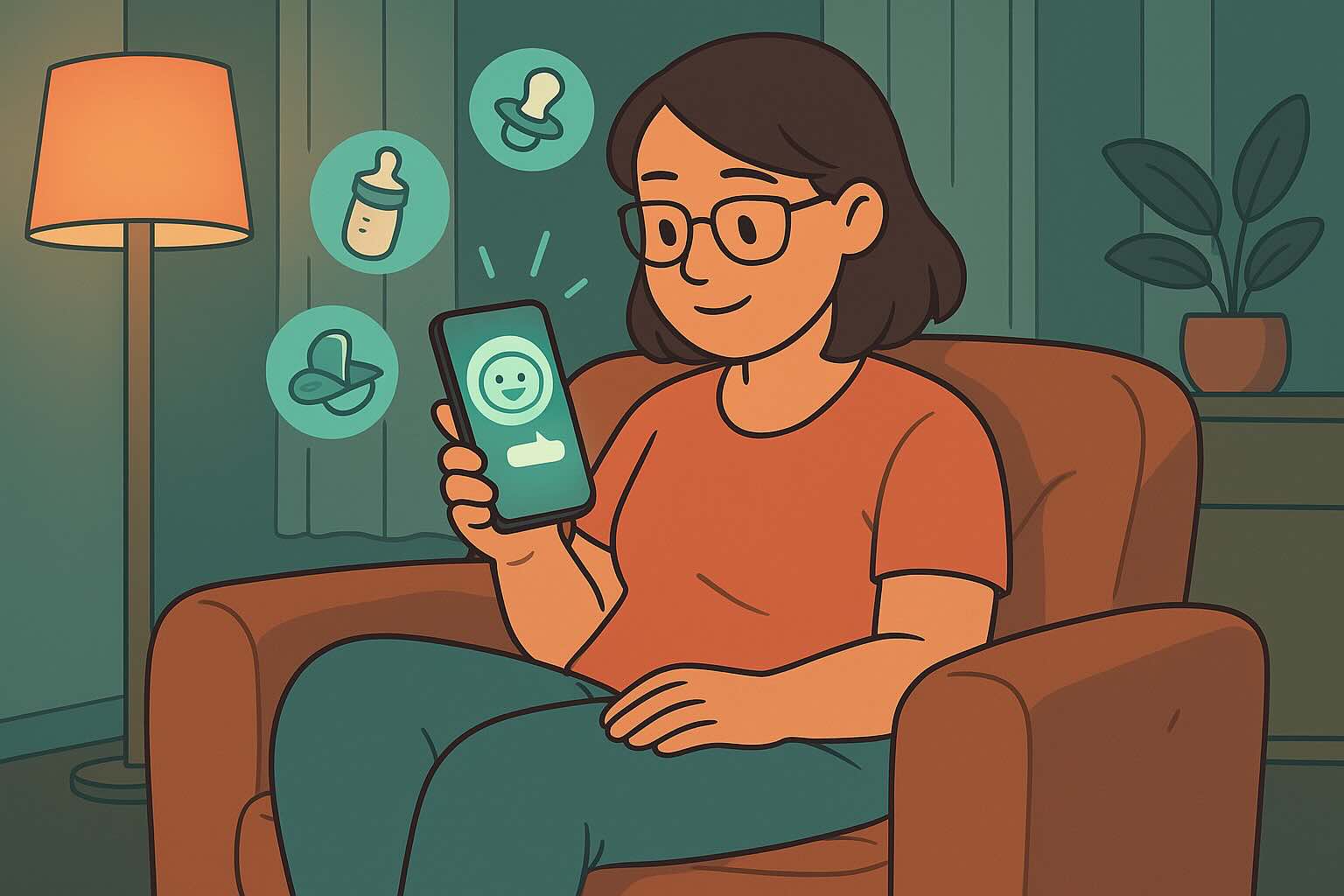
Get Your Free Sleep Training Toolkit
5-day email course + printable sleep log to help your baby sleep through the night
Frequently Asked Questions
Need personalized support?
RootWise's AI coach can provide tailored strategies for your specific situation, available 24/7 when you need it most.
Learn More About AI Coaching →